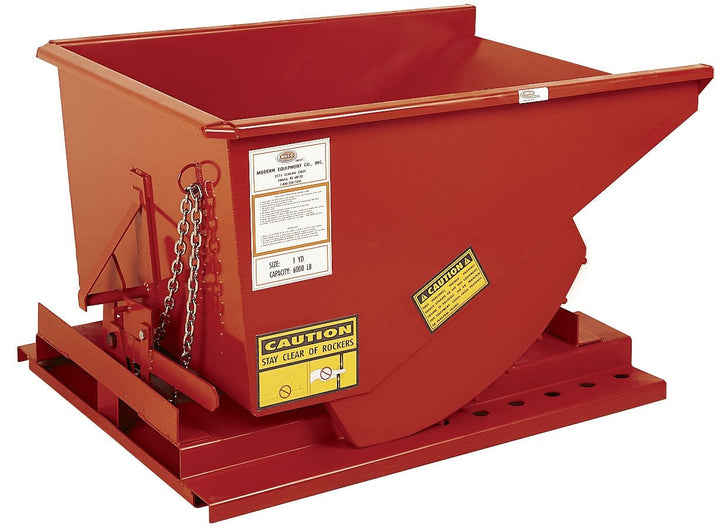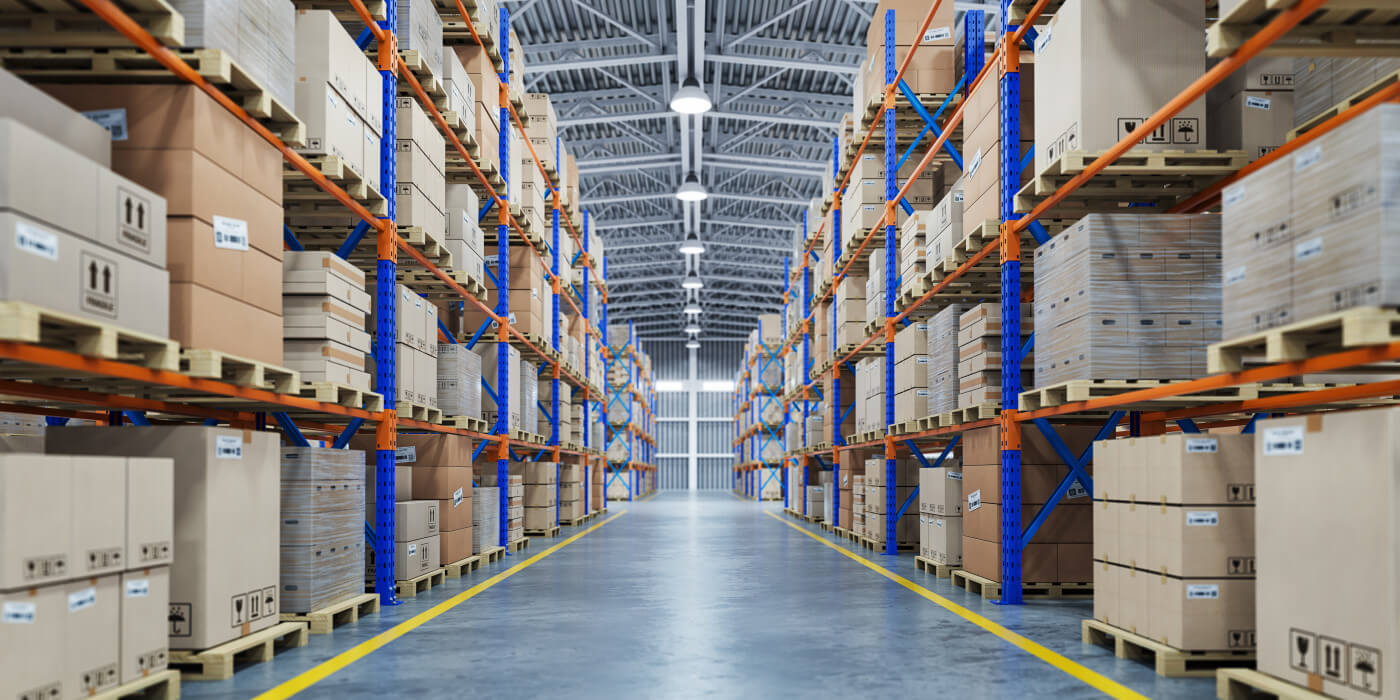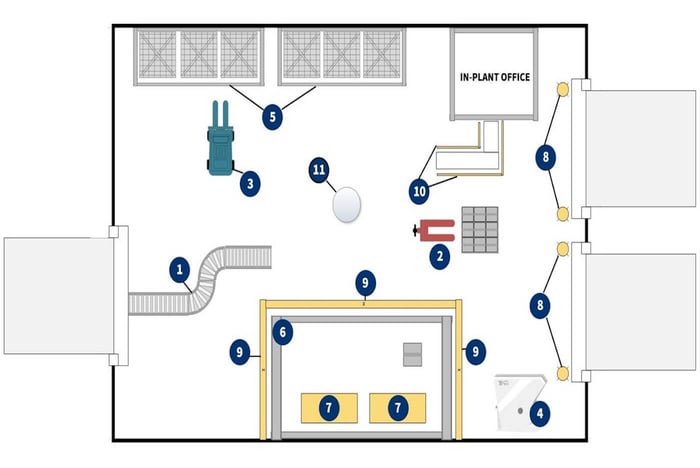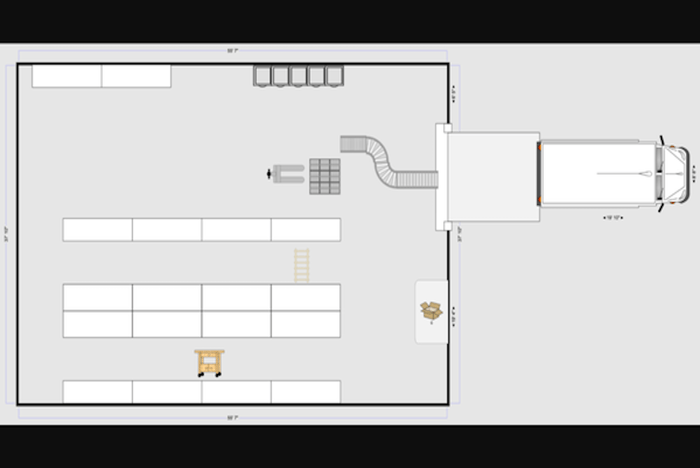An optimized layout is only one part of the equation, however. Without the people and proper equipment to store, transport, and secure your products, even the most well-designed warehouse will experience operational inefficiencies.
Essential Equipment For Moving Products In, Out & Around Your Warehouse
To get products flowing in your warehouse efficiently, your processes need to be optimized from the get-go. The systems and equipment that you use to get products unloaded have a significant impact on the speed of how they move through your warehouse. The following essential warehouse items will help you reduce bottlenecks to get items flowing into the staging area without the potential of overflow, not only leading to a more efficient warehouse but a safer one as well.
1. Gravity Conveyor
Adding a set of gravity conveyors at the inbound dock helps your logistics team get unpalletized product quickly and efficiently from the truck. Gravity conveyors help minimize walking time and conserve employee effort by allowing physics and the conveyor itself to do the heavy lifting.
Gravity conveyors are equipped with rollers that allow you to either push products down the conveyor with employee assistance or roll the product down the conveyor if you have it positioned at a downward angle. If you plan on transporting products using the latter of the two methods, make sure to implement some type of guard rail system on all sides of the conveyor to prevent products from falling off while in motion.
If you’re looking for added versatility, consider a flexible gravity conveyor system, like the NestaFlex system sold here at BMH. Our NestaFlex gravity flexible gravity conveyors can be configured in a variety of curves and angles and are equipped with roller wheels at the bottom so that you can create your own unique transport paths to and from your loading docks.
2. Pallet Jack
If you’re storing inventory on pallets or shipping products out on pallets, a pallet jack is a critical piece of equipment for your warehouse.
Pallet jacks are typically available in two types: manual and electric. Manual pallet jacks are essentially hand-operated forklifts that allow you to transport pallets within your warehouse. Manual pallet jacks (also called pallet trucks) function similarly to a car jack. The forks of the pallet jack are inserted into the pallet at ground level, then the pallet jack lifts the pallet off the ground, allowing you to move the pallet freely around. Load capacities are typically between 1,000 to 5,000 lbs.
Electric pallet jacks are battery operated and can help speed up the process of loading or unloading products by eliminating the need to manually jack the pallets up by hand. An example of an electric pallet jack can be found here. Electric pallet jacks can also handle a load of upward of 5,000 to 6,000 lbs, however, because they are battery operated the total operational time between charges can be a potential bottleneck when it comes to moving products in and around your warehouse. If you’re considering an electric pallet jack, be cognizant of the total operational time so you don’t end up with a dead battery!
3. Forklift
If you’re receiving products on pallets and have a storage system that relies on vertical storage space in your racks, a forklift is another necessary piece of equipment that your warehouse needs.
Forklifts have much higher load capacities than pallet jacks. Additionally, pallet jacks only allow you to move pallets at the ground level, whereas forklifts can help you elevate your products up to 35 feet (depending on the forklift manufacturer).
Smaller warehouses that rely on industrial shelving or shorter pallet rack systems can probably get away with a pallet jack as their main transportation medium for moving products in, out, and around their warehouse. However, higher volume warehouses where there is a constant flow of products throughout the day will most likely need at least one forklift.
Because forklifts can carry heavier loads and can move faster than a manually (or electrically) operated pallet jack, a greater number of pallets can be moved per hour versus a standard pallet jack. As a warehouse manager, you should consider the total cost per pallet moved when factoring in the decision to invest in a forklift.
The lower up-front cost of a pallet jack may sound economical at first, however, the total cost per pallet moved could be lower with a forklift when you factor in the number of pallets that flow through the warehouse and the labor costs associated with it.
Visit our website to view our new and used forklift selection and to get a quote.
4. Hoppers
As products come into your warehouse, chances are there is additional packaging that needs to be removed in the staging area before transferring those products onto pallets and into their final storage destination. When dealing with waste in bulk, hoppers are an efficient option that helps save time and labor costs.
If you’re unloading smaller inventory, hopper trucks are a great solution to help you dispose of waste and extraneous materials. Hopper trucks are equipped with wheels that allow you to transport waste to the nearest disposal point. Hopper trucks like these are made for lighter duty operations where the transport load is under 1,000 lbs. However, if your warehouse has bigger needs for getting rid of waste, self-dumping hoppers might be a better option.
Self-dumping hoppers (such as the ones shown below) have great storage capacities, ranging from 2,000 lbs, upward to 6,000 lbs. Self-dumping hoppers can also be equipped with wheels, like a traditional hopper truck, and automatically dump the load when the locking latch is released, thus saving time and labor hours when it comes to waste disposal within your warehouse.
NEW SELF DUMPING HOPPER, 1.0 CU YD, 6,000# CAP, ORANGE

$1,050.00
Excellent for handling heavy, bulky scrap, in-process materials, castings, wood and metal chips, recyclables and sludge. Sealed watertight for wet or dry use Positive, locking latch prevents accidental dumping Safety chain secures hopper to the handling vehicle Ships fully assembled… read more
Essential Equipment For Storing Products In Your Warehouse

Once your products come off the truck, you’ll need a way to store your products and make them easily accessible for fulfillment or picking. Special considerations need to be made when it comes to the storage aspect of your material handling strategy, including (but not limited to):
- The square footage of your warehouse
- The height of your warehouse ceilings
- The design of your warehouse, factoring in where walls, dock doors, and other structural elements like mezzanines are located
- The types of products you are storing
- Your warehouse accounting method
- The volume of products moving through your warehouse
All warehouses will have different equipment requirements based on these variables, however, at the most basic level, most warehouses will need at least one of the three types of storage solutions: pallet racking or industrial shelving, wire mesh cages, and flammable storage cabinets.
5. Pallet Rack / Industrial Shelving
Most modern warehouses utilize a combination of both pallet racking and industrial shelving to fulfill their storage requirements.
A specific type of pallet racking, called selective pallet racking, allows warehouse operators to select any pallet in your racking system without having to move any other pallets. To leverage this type of pallet racking system, your warehouse account method should be First In, First Out (FIFO). Using a selective pallet racking system works best for businesses that need easy access to a wide variety of SKUs. Selective pallet racking is what is found in most warehouses today.
The most common type of selective pallet racking used in modern warehouses is teardrop pallet rack. Teardrop rack has teardrop-shaped punching holes on the uprights that allow the beams to sturdily rest on the uprights, minimizing flex and movement in the system. Wire decking is often installed in the pallet rack system to create a strong, reliable foundation for storing pallets and products for easy accessibility by hand, pallet jack, or forklifts.
For a full primer on selective pallet racking and whether it is right for your warehouse, consider reading our in-depth guide about selective pallet racking by clicking here.
Pallet racking is designed to handle the storage of large, palletized loads, but what if you need even faster, easier access to products that need to move more quickly? The solution: industrial shelving.
Industrial shelving is available in three main types: wide-span shelving, clip shelving, and rivet shelving. All three types of industrial shelving share the same purpose: to allow fast picking of hand-loaded items. Industrial shelving systems have a similar construction to pallet racking in the sense that they consist of uprights, beams, and shelves. The main difference between the three types of systems is in the material composition and capacity of each.
Wide-span shelving, also called long-span shelving, has the greatest storage surface area of the three types of industrial shelving. Wide-span shelving systems, like the ones seen here, can handle up to 2,500 lbs of storage. This makes wide-span shelving a great option for lighter, smaller inventory that needs to move fast off the shelf.
Rivet shelving is characterized by the teardrop-shaped holes on the uprights, similar to a teardrop pallet rack system. Rivet shelving has a lower weight capacity than wide span shelving and typically isn’t available in long widths like wide span shelving, but is still a good option for warehouses that don't have a large number of hand-picked items. The construction of a rivet shelving system is the least complex of the three types of industrial shelving, making it the fastest to construct and is usually the least expensive of the tree.
Clip shelving is an industrial shelving system that is made completely out of steel. Clip shelving systems usually also have additional bracing and clips to secure the shelving in place, making it the sturdiest and most durable of the three. Clip shelving is mainly used in warehouses where abrasive products (such as chemicals) need to be stored. Clip shelving tends to be the most expensive option.
Most, if not all warehouses will need to use a combination of pallet racking and shelving. Pallet racking’s utility comes from its ability to handle the longer-term storage of heavier items and pallets. As products move throughout your warehouse and closer to the fulfillment or packing stations, items can be removed from the pallets and stored on industrial shelves for faster access by your fulfillment team.
View our inventory of new and used in-stock pallet rack and industrial shelving
6. Wire Mesh Cages
Wire mesh cages prevent unauthorized access of your inventory inside of your warehouse. Regardless of how large or small your warehouse is, there’s a high probability that you’ve got expensive equipment that needs to be secured. That’s why wire mesh cages are an essential piece of equipment for any warehouse.
Wire mesh cages can be found in 2-sided, 3-sided, and 4-sided configurations, allowing a lot of flexibility for installing them to fit any warehouse layout. Wire mesh cages, like the ones found here, also have options for a locked hinged door or sliding door, and come with a sweep space for easy housekeeping. From a safety standpoint, wire mesh cages have a completely open-air ceiling to allow for unobstructed protection from fire suppression systems.
Outside of storing valuable inventory, wire mesh cages can also be used to enclose HVAC systems, pumps, servers, or other types of important warehouse equipment that aren’t directly used in the material handling processes within your facility.
View our inventory of in-stock wire mesh cages
7. Flammable Storage Cabinets
Flammable storage cabinets are an essential component for warehouses that store flammable liquids, regardless of industry. Flammable liquids are defined as any liquid having a flashpoint at or below 199.4 degrees Fahrenheit, or in other words, the point that a liquid emits enough vapor to with the air near the surface of the liquid.
When purchasing a flammable storage cabinet for these purposes, consider purchasing a used flammable storage cabinet to save on budget.
View our inventory of new and used in-stock flammable storage cabinets
Essential Equipment Designed To Protect Your Employees & Uphold OSHA Regulations
According to OSHA, the fatal injury rate in warehouses is higher than the national average for all industries. The constant moving and unloading of products in a typical warehouse paired with the use of heavy machinery presents many opportunities for your workers to become injured on the job. Fortunately, most of these injuries can be prevented with the right systems and equipment in place. Below is a list of the most essential warehouse items for safety that all warehouses should be using in their logistics operations.
8. Dock Bollards
Protecting your equipment is important, but keeping your employees safe trumps everything else. When installed near your loading and unloading docks, steel safety bollards can help prevent unforeseen accidents between vehicles (trucks or forklifts) and your employees.
Dock bollards are typically bright yellow which makes them more visible to employees and vehicle operators, and for OSHA compliance. For added strength, bollards can also be filled with cement, adding peace of mind for your team working in and around your docks.
Bollards can also be installed at other places in your warehouse outside of the docking areas, near pallet racking, for example. Bollards installed near pallet racks can help prevent collisions between forklifts, pallet jacks, and your rack to maintain the structural integrity of your rack while also keeping your employees safe.
View our in-stock inventory of safety bollards
9. Guard Rail
Guard rails are another essential safety component that all warehouses should have on their floor. Guard rails are both a physical and visual barrier to protect your employees and products from vehicle-related accidents within the warehouse. If you’ve got at least one forklift in your warehouse, you should have guard rails in place to protect your high-value equipment and product in key locations.
In the diagram above, a guard rail system is installed around the wire mesh cage on the warehouse floor. The wire mesh cage itself is not strong enough to withstand a potential collision with a forklift, so the guard rail system rectifies this weak point by protecting the equipment or inventory contained with the cage from accidents.
Guard rail should separate work areas from forklift driving areas. Other key places to consider installing guard rail in your warehouse would be around in-plant offices, shipping and packing stations, near expensive machinery, or at the ends of pallet racking.
View our in-stock inventory of guard rail
10. Handrail
Handrail is another physician and visual barrier that all warehouses should use to protect their employees. Handrails should be used in and around all docking areas, especially elevated docks, to prevent employees from accidental falls. Like guard rails, handrails can be used to create separation between forklift areas and employee areas to keep everyone safe.
In the diagram above, a handrail system is installed on the walkway leading up to the in-plant office. This not only protects the office itself from forklift collisions, but it also protects employees who are walking out of or into the implant office from forklift accidents as well.
11. Mirrors
Strategically placing mirrors in your warehouse is an often overlooked key to preventing unnecessary accidents in the workplace. The most effective type of mirror is a 360-degree dome mirror, which allows for visibility from all angles in highly trafficked areas within your warehouse.
By implementing a 360 dome mirror in the middle of your warehouse and other key areas like corners and near the end of pallet racking aisles, employees can look to see if forklifts or other potential dangers lie in their blind spots. Conversely, forklift operators can get a clear view of what’s not in their direct line of sight.
View our in-stock inventory of mirrors
A Single Source For All the Essential Warehouse Items
Whether you’re setting up a new warehouse, or looking for ways to improve the efficiency and safety of your existing one, BMH has everything you need to get your operations running smoothly. Unlike other material handling suppliers, we have a full inventory of in-stock equipment, available for same-day pickup or delivery. If you’re looking to expand on a budget, we also have a wide selection of used pallet racking, industrial shelving, pallet jacks, and more.
Click here to contact us or give us a call at 866-323-8310 to speak with a sales engineer today!




